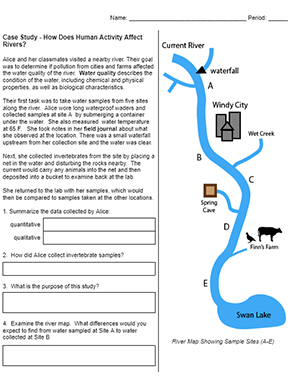
I designed this case study for a freshman biology class. The last unit focuses on human impacts on the environment. I would love to be able to take my class to an outdoor site to collect water samples, but this just isn’t feasible. Instead, I created a map of a fictional river with collection sites where data was collected. The sites are located near cities, springs, and farms which affects the water samples.
One section asks students to make predictions about the water quality at the different sites. Then students learn terminology, such as dissolved oxygen, biochemical oxygen demand, suspended solids, and fecal coliform bacteria. Students use a data table to determine which sites have the most pollution.
A third section discusses how water quality affects the types of macroinvertebrates present in the sample Some species, like sludge worms have a high tolerance for pollution. Other species, like mayfly nymphs have a low tolerance. For this section, I bring in a sample of water from a creek nearby. Students can see some of the organisms in the water even without a microscope. I even demonstrate how water test kits can be used to measure nitrates and oxygen content.
Finally, students suggest a location to build a campground based on the water quality. Overall, this is a fairly simple exercise for freshman and it sparked a lot of discussion. The case took about two days to complete, but we went slow and I gave them time to examine water samples. This is also a good way to reinforce how ecologists collect data using random sampling.

